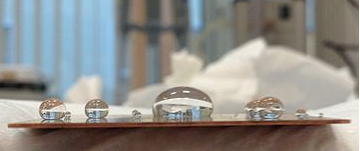Superhydrophobic surface

Superhydrophobic surfaces can delay ice formation by their water repellent surface. Hydrophobicity increases the droplet movement, which can reduce icing.
During freezing, water will penetrate the topography of a surface, which increases the ice-surface- contact area that increases the ice adhesion strength. Low interactions between the surface and water lead to hydrophobicity of the surface. Hydrophobicity has been discussed to lead to icephobicity of the surface due to low interactions. Good icephobic coatings have the proper combination of wettability (hydrophobic or superhydrophobic), suitable surface roughness and low surface free energy.
Droplets movement on the surface is dependent on the contact angle. Studies have shown, that when the contact angle grows, the ice adhesion strength decreases. On superhydrophobic surfaces, water droplets show a very high contact angle (greater than 150°) that explains the low wettability of the surface[2].
Superhydrophobicity has been shown as a possible option for icephobicity. However, some studies have shown, that superhydrophobicity does not always mean good icephobicity. One of the main problems against using superhydrophobic surface for icephobicity is that the surface is damaged by icing. Another problem encountered in studies is humidity. In a very humid atmosphere, the anti-icing of superhydrophobic surfaces is greatly diminished.
microroughness and nanoroughness.
[3] [4] [5] [6] [7] [8] [9] [10] [11] [12]
References
- ↑ Galiya Magazova. Creative Commons Attribution-Share Alike 4.0. Superhydrophobic surface.JPG.
- ↑ Meuler, A. J. et al., 2010. Relationships between Water Wettability and Ice Adhesion. ACS Applied Materials & Interfaces, 2(11), pp. 3100-3110.
- ↑ Li, G. (2018). Fundamentals of icing and common strategies for designing biomimetic anti-icing surfaces. Journal of Materials Chemistry. A, Materials for Energy and Sustainability, 6(28), 13549–13581.
- ↑ Ingvaldsen, K. (2017) Atmospheric icing in a changing climate: Impact of higher boundary temperatures on simulations of atmospheric ice accretion on structures during the 2015-2016 icing winter in West-Norway.
- ↑ Meuler, A. J. et al. (2010) Relationships between water wettability and ice adhesion., ACS applied materials & interfaces, Vol. 2, No. 11, 2010, pp. 3100– 10.
- ↑ Stenroos, C. (2015) Properties of icephobic surfaces in different icing conditions.
- ↑ Jeevahan, J. (2018). Superhydrophobic surfaces: a review on fundamentals, applications, and challenges. Journal of Coatings Technology and Research, 15(2), 231–250.
- ↑ Farhadi, F. (2011). Anti-icing performance of superhydrophobic surfaces. Applied Surface Science, 257(14), 6264–6269.
- ↑ Antonini, I. (2011). Understanding the effect of superhydrophobic coatings on energy reduction in anti-icing systems. Cold Regions Science and Technology, 67(1), 58–67.
- ↑ L. Makkonen, Ice Adhesion — Theory , Measurements and Countermeasures, Journal of Adhesion Science and Technology, vol. 26, 2012, pp. 413–445.
- ↑ M. Zou, S. Beckford, R. Wei, C. Ellis, G. Hatton, M. A. Miller, Effects of surface roughness and energy on ice adhesion strength, Applied Surface Science, Vol. 257, No. 8, 2011, pp. 3786–3792.
- ↑ S. Farhadi, M. Farzaneh, S. Simard, On Stability and Ice-Releasing Performance of Nanostructured Fluoro-Alkylsilane-Based Superhydrophobic Al alloy2024 Surfaces, International Journal of Theoretical and Applied Nanotechnology, Vol. 1, No. 1, 2012, pp.38-45.